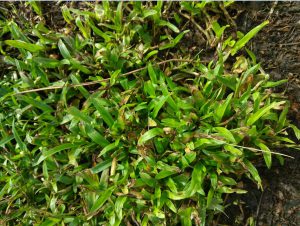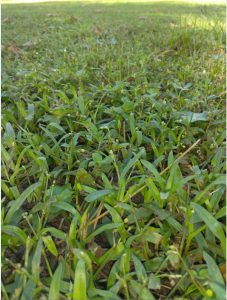As the Fall season has finally come, we are still seeing warm and wet summer weather. These conditions are perfect for a troublesome pasture weed, called Doveweed (Murdannia nudifflora). This summer annual weed is in the dayflower family and has become an increasing annoyance in the pastures and hay fields.
Characteristics

The doveweed flower has three purple/blue petals and usually three seeds that can be dispersed by water movement or mechanical force such as mowing. Doveweed grows close to the ground where livestock will typically not graze on it and creeps outwardly. This weed can be spread by seed, but also by vegetative propagation. Because of this, mowing can cause this weed to spread even more. The spreading nature of this weed can aggressively cover and choke out bahiagrass, limiting grazable area for livestock. Doveweed prefers wet areas, so the rainy weather conditions we have been having, create an ideal environment for the establishment and expansion of this weed. The weed will continue to grow through the summer months and into the fall until temperatures start to fall below 70° F.

Photo Credit: Luke Harlow
Doveweed Control
At this time in the season, doveweed should start dying back as the weather, while still warm, is cooling down. If the weed population is not exceeding large, no action may be necessary. Consideration of wet areas should be looked at to try to limit moisture in the pastures as much as possible. If chemical control is warranted, there are limited options to control doveweed in the pastures.
Glyphosate
If the doveweed is limited to a small area and has completely killed the bahia under it, a direct application of glyphosate (RoundUp) at 1 lb ae/ac followed by re-seeding the area at an appropriate time of year is more effective.
2-4-D or GrazonNext HL
Products containing 2,4-dichlorophenoxyacetic acid (2,4-D) applied at the maximum recommended label rate or the use of GrazonNext HL applied at a rate of 24 oz./ac should provide adequate control of doveweed in bahia pastures. However, additional applications may be necessary for full control.
Because of the lifespan of the weed seeds, it may take more than one or two years to effectively control doveweed in the pasture. One of the greatest management factors to prevent doveweed problems is to make sure the pasture grass is full and healthy. This will limit the amount of sunlight that is needed for doveweed to seed and spread.
For more information on doveweed: http://edis.ifas.ufl.edu/ag395
 0
0
